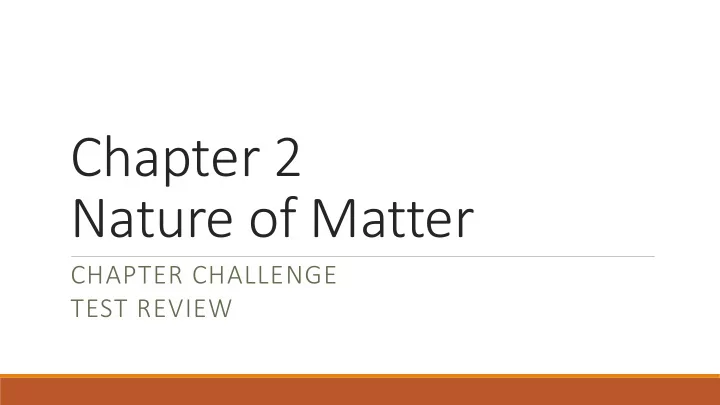

Chapter 2 Nature of Matter CHAPTER CHALLENGE TEST REVIEW
Chapter 2 Challenge – Jeopardy Round The Small Mole-cools Legos of Life The World Super Party Things In Life Within Extravaganza 100 100 100 100 100 200 200 200 200 200 300 300 300 300 300 400 400 400 400 400 500 500 500 500 500 600 600 600 600 600 700 700 700 700 700 800 800 800 800 800
ATOMIC PARTICLES Protons, Neutrons, and Electrons
ELECTRON Found in the space surrounding the nucleus, & has a negative charge
ATOMIC MASS Protons plus Neutrons, “weight” of an atom
ISOTOPE Same number of protons, different number of neutrons. Ex. Carbon-14
ATOMIC NUMBER The number of protons in an atom, also identifies the element
NUCLEUS Where Protons and Neutrons are found
PROTONS Atomic particle with positive charge
NEUTRONS Atomic particle with neutral charge
2 Hydrogen and 1 Oxygen Chemical composition of water molecule
COMPOUND Substance formed by the chemical joining of two or more elements in definite amounts
COVALENT BOND Bond in which electrons are shared
IONIC BOND Bond in which electrons are transferred
HYDROGEN BOND Bond that forms between two water molecules
POSITIVE ION Type of ion that forms when an atom loses an electron
SOLUTION Mixture in which the substances are evenly spread out
SOLVENT Something that dissolves something else in a solution
SOLUTE Something that dissolves in a solution
VALENCE ELECTRON Type of electron that is available to form bonds
ADHESION Attraction of molecules between different substances
SUSPENSION A solution that contains particles that cannot be dissolved
BASE A solution with a pH above 7
ACID A solution with a pH below 7
POLARITY When one side of a molecule has a slightly negative charge, and the other side has a slightly positive (think poles)
CARBON Element that has four valence electrons, and forms strong covalent bonds with many other elements
MACROMOLECULES Giant molecules that are made from thousands or even hundreds of thousands of smaller molecules.
POLYMER Many monomers that join together to form long chains
CARBOHYDRATES Composed of Carbon, Hydrogen, and Oxygen. Includes Monosaccharides & Polysaccharides
PROTEINS Composed of Carbon, Hydrogen, Oxygen & Nitrogen. Assembled from Amino Acids
LIPIDS Composed of Carbon, Hydrogen, & Oxygen and is composed of a glycerol and a fatty acid. Source of long term energy storage and make up cell membranes
NUCLEIC ACIDS Composed of Carbon, Hydrogen, Oxygen, Nitrogen and Phosphorous Stores genetic information.
SIMPLE SUGARS Glucose, fructose, and galactose
CHEMICAL REACTION Process that changes, or transforms one set of chemicals into another
REACTANTS “Ingredients” in a chemical reaction
PRODUCTS What reactants transform into during a chemical reaction
ACTIVATION ENERGY Energy needed to get a reaction started
CATALYST Substance that speeds up a chemical reaction
ENZYME Made of proteins, affect the speed of a chemical reaction by lowering the activation energy
ACTIVE SITE Part of an enzyme that provides an area for the substrate to attach
SUBSTRATE The molecules that are to be broken down or put together by an enzyme.
pH pH A measurement used to test the concentration of H+ ions in a solution.
Recommend
More recommend